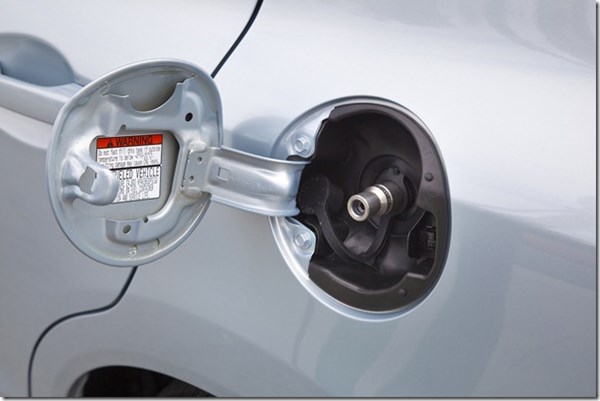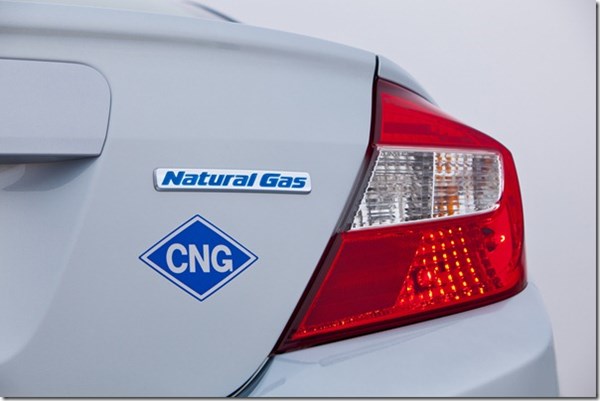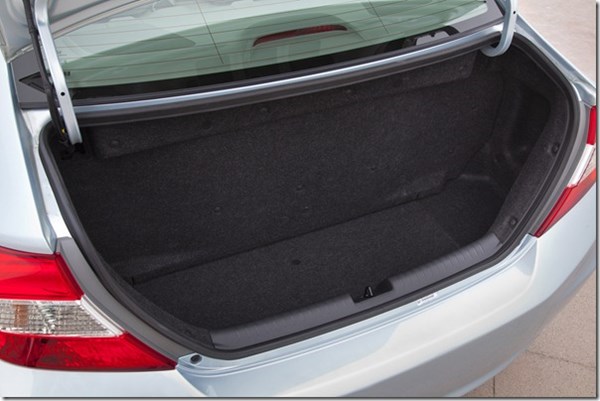2012 Honda Civic Natural Gas
The absurdity is striking: The natural gas-powered Honda Civic delivered to Autofieldblog.com HQ has California license plates on it.
#interior
The absurdity is striking: The natural gas-powered Honda Civic delivered to Autofieldblog.com HQ has California license plates on it. I was concerned with driving across town in it. I can’t imagine a road trip with the car.
It’s not that there’s anything wrong with the vehicle per se. The problem is that there are too few places to get compressed natural gas (CNG) pumped in the Detroit metropolitan area. Go to http://www.cngprices.com/station_map.php and type in 48170, our zip code. And you’ll find that you have to keep making the map bigger and bigger to find stations.

So I went to what appeared to be the closest one. A 42-mile round trip. An hour of pointless driving. I went into the service station building, planning to prepay. “Oh, we don’t take money for that pump”—I should point out that in a plaza full of numerous islands, there was one lone pump (two nozzles) for compressed natural gas—“that belongs to DTE, so you have to use a credit card.” DTE is the prevailing energy utility in these parts. Yes, there is a credit-card reader. No, it isn’t at all like the one you’re familiar with on gas pumps. After getting that to work—sort of—it was hooking up the nozzle of the pumping device to the vehicle.

The coupling for fueling the Civic is a precision turning. It is a piece of serious hardware. So you might assume that the business end of the fueling unit would resemble something from NASA rather than from one of those carnival rides that show up in church parking lots. Visual feedback of proper hookup would have been nice. I tried it a few times to make sure that it was just so. And hoped.
At first, nothing happened. I figured that it was a problem with the credit card device again. Nope. Suddenly it started pumping. Admittedly, with a low comparable price vis-à-vis gasoline (about $1.10 per equivalent gallon difference) the numbers didn’t roll as high. It stopped. It started. It stopped. It was, I concluded, done.
While it may seem trivial and possibly petty, bringing a new technology to the market is one that ought to have a Disney-level experience associated with it.

And this is something about the infrastructure, not the car. We’ll get to that. But this is a problem that consumers and OEMs alike are going to have to face, not just vis-à-vis CNG, but other alternative energy sources, be it electricity or hydrogen.
It is a little chicken-and-egg. Do you put up a number of “regular” CNG pumps when there is little demand or do you wait for greater demand? Do you build cars that run on a fuel that isn’t everywhere and always regularly available?
And think about this: Chances are good that you have a natural gas line running to your house for your furnace or stove, hot water heater or dryer. It is so reliable that it is transparent.
Think about hydrogen, which you don’t have pumped to your house. Isn’t that infrastructure build-out going to be an even greater undertaking?
Or think about electric vehicles. Even though my refueling experience was tedious, it was still measured in minutes, not hours. And even though there was but one island in an archipelago of gasoline and diesel pumps, imagine the situation of a charging station or two. . .already hooked up to vehicles as your energy meter indicates depletion is nigh.
Starts making Big Oil look good, doesn’t it?
OK. The car.
This is a new Civic.
And as seemingly everyone knows, the critical reception to that car—ranging from Consumer Reports to Car Magazines Du Jour—has been, well, critical, particularly as regards the materials used on the interior (a passenger suggested to me that the skin of the instrument panel resembled an old person’s skin) and dynamic performance. The materials are what the materials are. Although lacking a test track or instrumentation, it is my sense that the ride and handling of the Civic is just fine—based on what this particular model of the car is meant to be, which is a car that runs on something other than gasoline. One might think that it is meant to be a “fuel-efficient” vehicle, but if one is looking for that, then other models in the Civic lineup can fit the bill better—and I’m not talking about the Hybrid.
That is, while the “regular” Civic has a 1.8-liter engine that provides 140 hp and 128 lb-ft of torque, the CNG Civic has a 1.8-liter engine, too, but it provides 110 hp and 106 lb-ft of torque. And according to Honda’s own numbers, whereas your Civic LX sedan has fuel efficiency numbers of 28/39/32 mpg city/highway/combined, they are 27/38/31 mpg for the CNG car. Go figure.

In addition to which, whereas the Civic sedan has a 12.5-cu.-ft.-capacity trunk, due to the packaging of the CNG tank, the other one has a 6.0-cu.-ft. space. Sort of tiny.
The CNG Civic was named the 2012 Green Car of the Year. So unless (1) you live next-door to a CNG station, (2) you live in a state where the car will get you a pass for the HOV lanes, (3) you are a staunch supporter of not using imported fuel, or (4) you are an overall green partisan, I don’t know why you’d opt for this variant of the Civic when there are more appealing possibilities in the lineup.
Selected specs
Engine: 1.8-liter I4
Material: Aluminum block and head
Horsepower: 110 @ 6,300 rpm
Torque: 106 lb-ft @ 4,200 rpm
Transmission: Five-speed automatic
Wheelbase: 106.3 in.
Length: 177.3 in.
Width: 69.0 in.
Height: 56.5 in.
EPA gasoline equivalency: 27/38 mpg city/hwy
Technorati Tags: CNG,Honda,Honda Civic CNG,electric vehicles,hydrogen
RELATED CONTENT
-
Injection molding for interiors—including fabrics
Plenty of interior components are injection molded. But some companies—such as VW—are using a process for trim pieces that both mold a component and cover it in fabric in a single molding process. And it is coming to the U.S. in the not-too-distant future.
-
About the 2019 Toyota RAV4
Last year Buick sold 219,231 vehicles in the U.S.
-
2019 Honda Insight
One of the things that rarely gets the amount of attention that it should in a typical “car review” is the fact that for a considerable amount of time drivers are not “getting on the throttle” because for a considerable number of drivers, they’re “dwelling on the binders,” a.k.a., sitting with their foot depressed on the brakes, perhaps lifting every now and then in order to nudge forward in traffic.


.jpg;width=70;height=70;mode=crop)